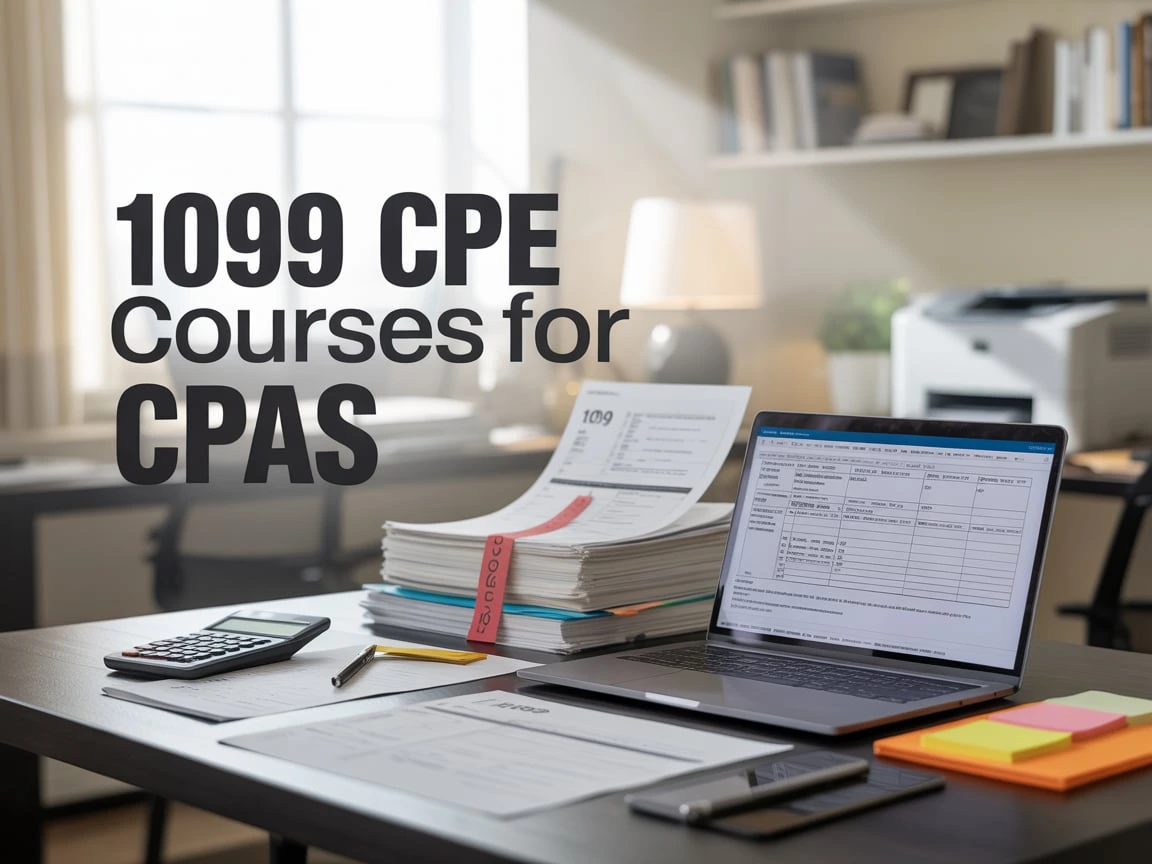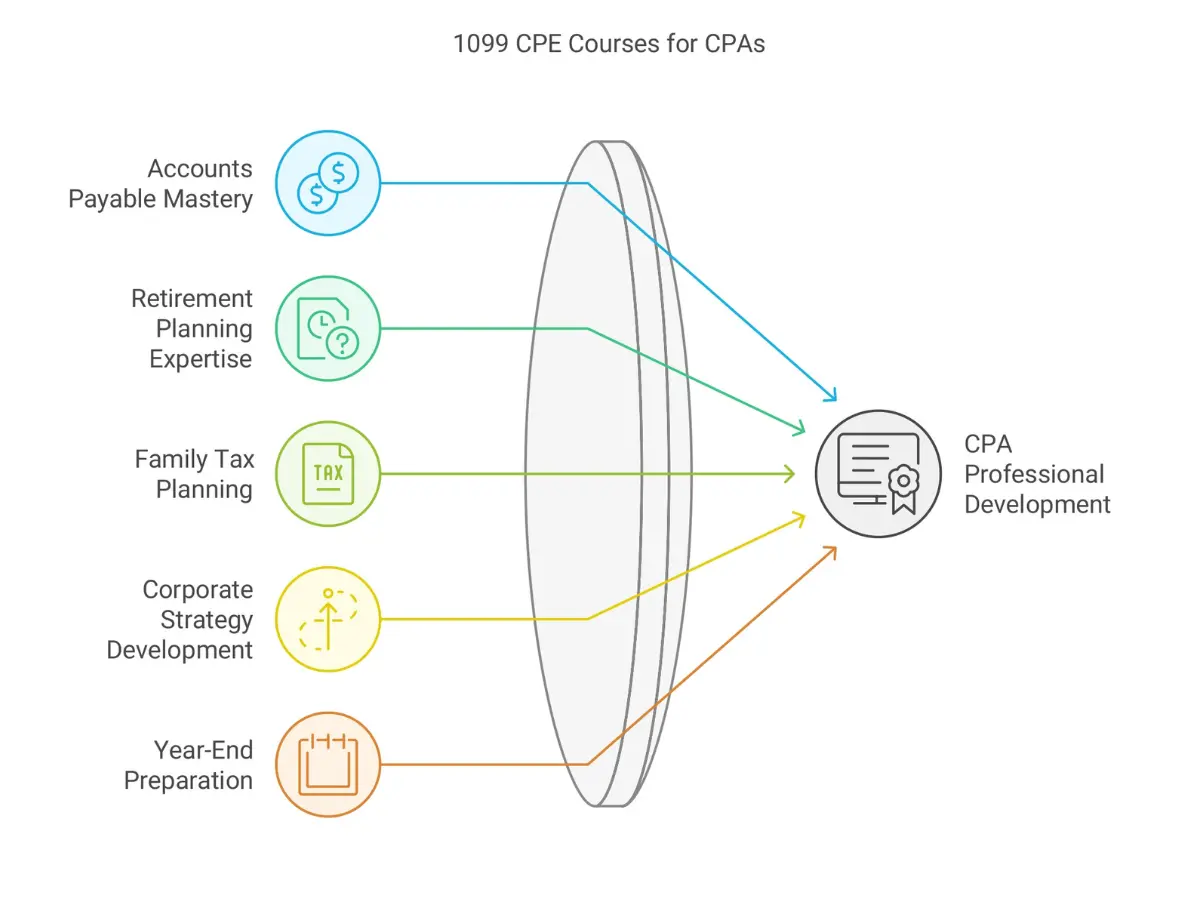1099 CPE Courses For CPAs |
| The Last Self-Study CPE Website You Will Ever Need (Click for Subscriptions) |
This page offers a curated list of online self-study 1099 CPE courses for CPAs and tax professionals who want to deepen their understanding of 1099 forms, improve accuracy in client reporting, and maintain their continuing education credits. Courses cover various 1099 types, tax implications, and year-end reporting essentials, accessible anytime through CPEThink.com.

1. Who is this list of CPE courses for?This list of CPE courses is designed for Certified Public Accountants (CPAs), tax professionals, and IRS Enrolled Agents who want to expand their expertise in 1099 forms and related tax reporting requirements.
2. What is this list of CPE courses about or what problem does this course solve?These courses focus on IRS Form 1099 and help professionals understand the differences between W-2 and 1099 reporting, common errors, and the various types of 1099 forms. Equipping them to better serve clients and prevent IRS compliance issues.
|
3. Why is this list of CPE courses important to a CPA, Accountant, or IRS Enrolled Agent?Understanding 1099 forms is critical for accurate tax reporting and advisory work; mastering them through CPE courses enhances credibility, reduces client errors, and helps practitioners avoid costly IRS notices and penalties.
4. When is this list of CPE courses relevant or timely?These courses are most relevant during year-end tax preparation, client reporting seasons, or any time professionals must stay current with tax form updates, such as the newer 1099-NEC requirements.
|
5. Where can this list of CPE courses be found and accessed?The 1099 CPE course listings can be found and purchased directly on CPEThink.com, an online provider of self-study continuing education for accounting professionals.
6. How is a list of CPE courses like this consumed or used?These CPE courses are delivered online in self-study format, typically through text or video, and completed at the learner’s own pace to earn verifiable CPE credits for license renewal and professional development.
|
As a tax practitioner, you’re most probably aware of how much the IRS likes 1099 forms.
These are the forms that let taxpayers accurately report their income generated from sources other than salary or job wages. When someone receives a 1099 form, he/she mustn’t ignore it because the IRS gets a copy of the same too.
And this is the reason why pursuing 1099 CPE makes you a valuable asset to your clients. Let’s see how 1099 CPE courses help you stand out from the competition by improving your knowledge as a tax practitioner.
By taking 1099 CPE courses, you’ll learn about many essential things about 1099 forms. For instance, the difference between a W-2 form and a 1099 form. Though both of these are information returns, a W-2 form is what an employer sends to its employees mentioning their individual salary, wage, and withholding tax information. On the contrary, a 1099 form documents different kinds of non-employment income such as interests, capital gains, dividends, etc. Online 1099 CPE courses will also help you understand that taxpayers must compare the income mentioned on their form 1099 to their own records because occasionally, these forms may come with errors. This is crucial because the IRS matches a person’s 1099s with his/her tax return and if the tax return doesn’t contain any income documented on 1099, the agency will send a notice to him/her stating that he/she owes taxes on the unreported income.

There’re different types of 1099 forms and each of them is used to report certain types of income. However, most taxpayers only receive a few of them. Here’s an overview of the most commonly used ones. You’ll be able to learn about these and more by pursuing 1099 CPE courses.
1099-INT
This form is utilized to report a taxpayer’s interest income received from brokerages, banks, or other financial institutions. If the interest goes over $10, the taxpayer will receive this form.
1099-MISC
If a taxpayer received rent, royalties, prizes, awards, or any other kind of income that’s not covered by any other 1099 form, the 1099-MISC is used to report it.
1099-NEC
This form was rolled out by the IRS in 2020 to report money that has been paid to individuals, who did work but weren’t employees of the payer. In short, individuals, who were self-employed or freelanced, should receive a 1099-NEC from their clients.
1099-R
When an individual received distributions from retirement plans, profit-sharing plans, pensions, annuities, insurance contracts, or IRAs, he/she should get a 1099-R from the plan issuer to report the income. Note that even if someone receives a 1099-R, not every distribution from tax-deferred or retirement accounts is taxable. Nontaxable distributions such as a rollover from a 401(k) plan into an IRA are also reported using this form.
1099-DIV
If a taxpayer received dividends or other distributions such as capital gains distributions, he/she will receive a 1099-DIV to report that income. Note that, dividends, which are classified as “qualified dividends”, are subject to lower capital gains tax rates. Dividends, which are classified as “ordinary dividends”, are taxed at regular tax rates.
As you can see, pursuing 1099 CPE can easily boost your income potential and strengthen your position as an expert tax practitioner. This is simply because all kinds of individuals can receive a 1099 form for a wide range of reasons and as they need to report each 1099 to fulfill tax obligations, they might need your help.
Check out what other customers are saying.